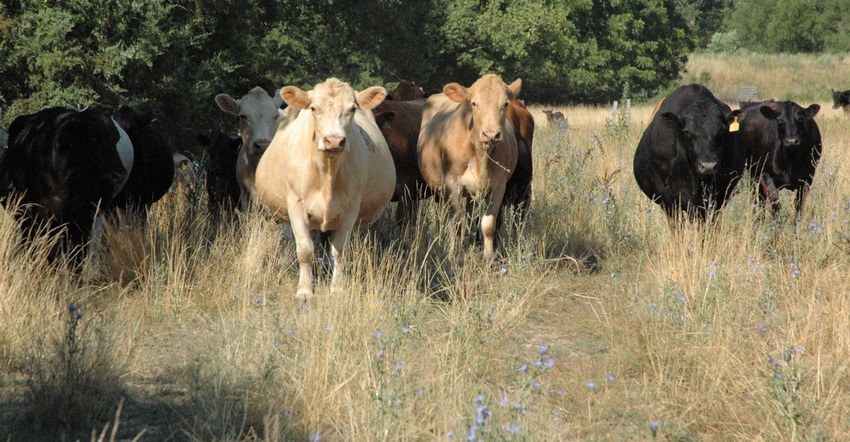Cut your cow losses, cull late-season calvers
Develop a short calving season to maximize profits on the beef farm.
April 22, 2021

University of Missouri beef cow-calf specialist Jordan Thomas looks at a beef herd like any businessman looks at an investment portfolio. If a cow doesn’t generate an acceptable return on investment, sell her off.
Consider the input costs and the equity tied up in a cow, he says, which by their very nature decline in value from one year to the next. And while there are good reasons to cull cows — such as bad teeth, temperament, drought and pregnancy status — Thomas says there are other cows that need to be marketed.
“Late-conceiving cows just are not going to generate enough profit compared to early-conceiving cows or stockers,” he says. By selling later-conceiving cows, he finds producers can help control some of that cost.
“Although it can feel like failure when we have to cull cows, we shouldn’t look at strategically marketing late-conceiving cows as failing,” Thomas says. “Look at it as an opportunity to free up equity that is tied up in animals that are poor investments. That is always a wise decision, especially when approaching the winter months without enough stockpiled forage. Late-conceiving females are just not a good investment.”
Switch to short-season calving
Data shows early calvers stay in the herd longer. Thomas supports a relatively short, well-managed breeding season, but he emphasizes the value of having a veterinarian perform a pregnancy examination to determine fetal age. Cows that conceived late will not only wean lighter-weight calves next year, but they also are more likely to not become pregnant in the following year’s breeding season.
Thomas says managing for a short or even an “ultra-short” calving season should determine which cows get to stay on the farm. He, along with MU Extension beef nutrition specialist Eric Bailey, is working on a multiyear project to carry out an ultra-short calving season at MU’s Southwest Research Center with the goal of managing for a calving season of only about 30 days.
The system can be done profitably through good reproductive management and removing late-conceiving cows from the herd.
Problem with winter feeding
Cows that conceive late in the breeding season go on to calve late in the calving season. As a result, Thomas says, they wean younger, lighter-weight calves. Yet those cows cost about the same amount to maintain all year long on the operation.
Those costs really matter, especially when forage is in short supply, Thomas says. Carrying low-productivity cows, especially through the winter months when feed costs are highest, drags down profits.
When deciding if cows stay or go, begin by calculating carrying capacity of the farm or ranch. Matching carrying stocking rate with carrying capacity is essential if the goal is to maintain cows through the winter with lower supplementation or hay costs, Thomas says.
Knowing the number of animal units that the land can support via grazing alone helps producers decide whether to destock or buy feed. MU Extension agronomists and livestock specialists can help producers estimate land’s carrying capacity, if needed.
“Most of us are used to thinking about destocking cows in drought conditions,” Thomas says. “We carry low-productivity cows until we run out of feed. But really, we need to ask if something else is more profitable. Those cows are eating up a forage resource that we could use in a much more profitable way.”
Focus on forage management
Bailey argues that the spring flush of forage is a much more valuable resource than we realize. All too often in Missouri, that forage simply gets harvested as hay — and often as low-quality hay because spring weather prevented a timely hay harvest. Thomas says long hay-feeding seasons and long calving seasons seem to go together, and both lead to lower profits.
Good forage management allows a longer grazing season, feeding less hay and adding weight to calves after weaning. In more research at Southwest Research Center, Bailey is studying how to increase profits by running fewer cows and adding stocker calves during peak forage months.
“Grass sells a lot better wrapped in calf hide than in cowhide,” Thomas says. “We need to allocate forage to profitable enterprises. If you consider the poor profits produced by later-conceiving, lower-productivity cows, it is clear they are not a good strategy for packaging that forage into calf value.”
MU Extension has beef cow-calf planning budgets for northern and southern Missouri operations available for download.
Source: University of Missouri Extension, which is solely responsible for the information provided and is wholly owned by the source. Informa Business Media and all its subsidiaries are not responsible for any of the content contained in this information asset.
You May Also Like
.png?width=300&auto=webp&quality=80&disable=upscale)


